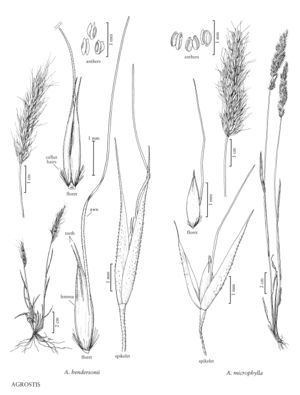Agrostis hendersonii
Plants annual. Culms 6-70 cm, erect, with 2-5 nodes. Sheaths smooth; ligules 0.5-5 mm, usually scabridulous, dorsal surfaces sometimes smooth, apices acute to obtuse, erose-lacerate, sometimes ciliolate; blades 1-4.5 cm long, 0.5-1 (2) mm wide, flat or weakly involute. Panicles 1-5 cm long, 0.5-1.5 cm wide, cylindrical, spikelike, dense, sometimes interrupted near the base, usually well exserted from the upper sheaths; branches scabridulous, ascending to appressed, mostly hidden by the spikelets, lower branches 0.5-2.5 cm; pedicels 0.5-4 (6.3) mm. Spikelets lanceolate, greenish to yellowish, tinged with purple. Glumes subequal, 5-7 mm, scabrous over the midvein, often sparsely scabridulous over the body, 1 (3) -veined, apices narrowly acuminate to awn-tipped to 2 mm; callus hairs to 0.7 mm, abundant; lemmas 2.5-4 mm, scabridulous over the veins and sometimes over the body, opaque to translucent, 5-veined, veins prominent distally, apices acute, veins extended into 2 teeth, teeth 0.2-1.5 mm, awned from about midlength, awns (5) 8-10 mm, more or less geniculate; paleas absent or to 0.9 mm; anthers 3, 0.4-0.7 mm. Caryopses 1.6-1.8 mm. 2n = 42.
Discussion
Agrostis hendersonii is a rare species that grows below 600 m in clay or adobe, sometimes rocky, soils around the edges of vernal pools in Oregon and California.
Agrostis aristiglumis Swallen, known only from its type locality on the Point Reyes Peninsula, Marin County, California, is included here in A. hendersonii. It differs from A. hendersonii in having a palea up to 0.9 mm long, and a barely exserted panicle. The relationship of these to each other and to A. microphylla merits investigation. Their differences may be the result of the founder effect on inbreeding annuals.
Selected References
None.
Lower Taxa
"decumbent" is not a number.
